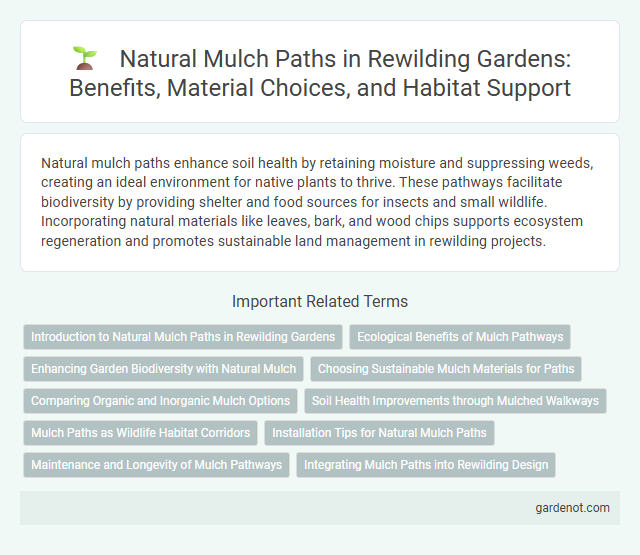Natural mulch paths enhance soil health by retaining moisture and suppressing weeds, creating an ideal environment for native plants to thrive. These pathways facilitate biodiversity by providing shelter and food sources for insects and small wildlife. Incorporating natural materials like leaves, bark, and wood chips supports ecosystem regeneration and promotes sustainable land management in rewilding projects.
Introduction to Natural Mulch Paths in Rewilding Gardens
Natural mulch paths serve as sustainable walkways in rewilding gardens, enhancing soil health by promoting microbial activity and moisture retention. Composed of organic materials like wood chips, bark, and leaves, these paths encourage natural decomposition and nutrient cycling, supporting surrounding flora. Their porous nature aids water infiltration and reduces erosion, aligning with ecological restoration principles fundamental to rewilding efforts.
Ecological Benefits of Mulch Pathways
Natural mulch pathways enhance soil health by improving moisture retention and reducing erosion, supporting diverse microbial communities essential for ecosystem balance. These paths suppress invasive weeds without chemical intervention, promoting native plant growth and habitat restoration. Mulch also aids in carbon sequestration, contributing to climate regulation within rewilded environments.
Enhancing Garden Biodiversity with Natural Mulch
Natural mulch paths foster garden biodiversity by creating a rich habitat for beneficial insects, fungi, and microorganisms that support plant health and soil vitality. Organic materials like leaves, wood chips, and straw decompose gradually, releasing essential nutrients and improving soil structure. This regenerative process enhances moisture retention and weed suppression, promoting a balanced ecosystem in rewilding gardens.
Choosing Sustainable Mulch Materials for Paths
Choosing sustainable mulch materials for natural paths enhances soil health, promotes biodiversity, and reduces environmental impact. Opt for organic options like wood chips from locally sourced, untreated hardwood, fallen leaves, or straw, which decompose naturally and enrich the soil. Avoid synthetic mulches to maintain ecosystem balance and support rewilding goals by providing habitats for beneficial microorganisms and invertebrates.
Comparing Organic and Inorganic Mulch Options
Organic mulch options like wood chips, leaves, and straw enhance soil fertility by decomposing and providing essential nutrients, promoting biodiversity and water retention in rewilding projects. Inorganic mulches such as rubber, gravel, or plastic sheets offer longer-lasting weed suppression and reduced maintenance but lack the soil-enriching benefits and can impede natural soil processes. Choosing between organic and inorganic mulch depends on specific ecological goals, with organic varieties supporting ecosystem restoration while inorganic options prioritize durability and erosion control.
Soil Health Improvements through Mulched Walkways
Mulched walkways act as natural mulch paths that significantly enhance soil health by conserving moisture, suppressing weed growth, and promoting beneficial microbial activity. These paths improve soil structure and fertility by gradually decomposing organic matter, which enriches the soil with essential nutrients. Consistent use of organic mulches in walkways supports rewilding efforts by maintaining a balanced ecosystem and fostering robust plant growth.
Mulch Paths as Wildlife Habitat Corridors
Mulch paths serve as vital wildlife habitat corridors by providing natural cover and food sources that support diverse species movement and foraging. These pathways enhance ecosystem connectivity, allowing small mammals, insects, and amphibians to safely traverse fragmented landscapes. Incorporating organic materials such as wood chips and leaf litter fosters soil health and mimics natural forest floors, promoting biodiversity in rewilding projects.
Installation Tips for Natural Mulch Paths
For effective installation of natural mulch paths, begin by clearing the designated area of weeds and debris to ensure a smooth, level surface. Apply a landscape fabric or biodegradable weed barrier beneath the mulch to suppress weed growth while allowing water permeability. Finally, spread a 3-4 inch layer of organic mulch such as wood chips or bark evenly to enhance soil moisture retention and support soil health.
Maintenance and Longevity of Mulch Pathways
Natural mulch paths require regular replenishment of organic materials, such as wood chips or bark, to maintain their protective layer against soil erosion and compaction. Proper maintenance involves monitoring moisture levels and controlling weed growth to enhance the path's durability and promote healthy soil ecosystems. Well-maintained mulch pathways can last several years, supporting rewilding efforts by providing sustainable, permeable walkways that minimize habitat disruption.
Integrating Mulch Paths into Rewilding Design
Integrating natural mulch paths into rewilding design enhances soil health by promoting organic matter decomposition and moisture retention. These paths facilitate biodiversity by providing habitats for insects and microorganisms critical to ecosystem restoration. Using locally sourced organic materials ensures minimal environmental impact while seamlessly blending human access with natural regeneration.
Natural mulch path Infographic

 gardenot.com
gardenot.com